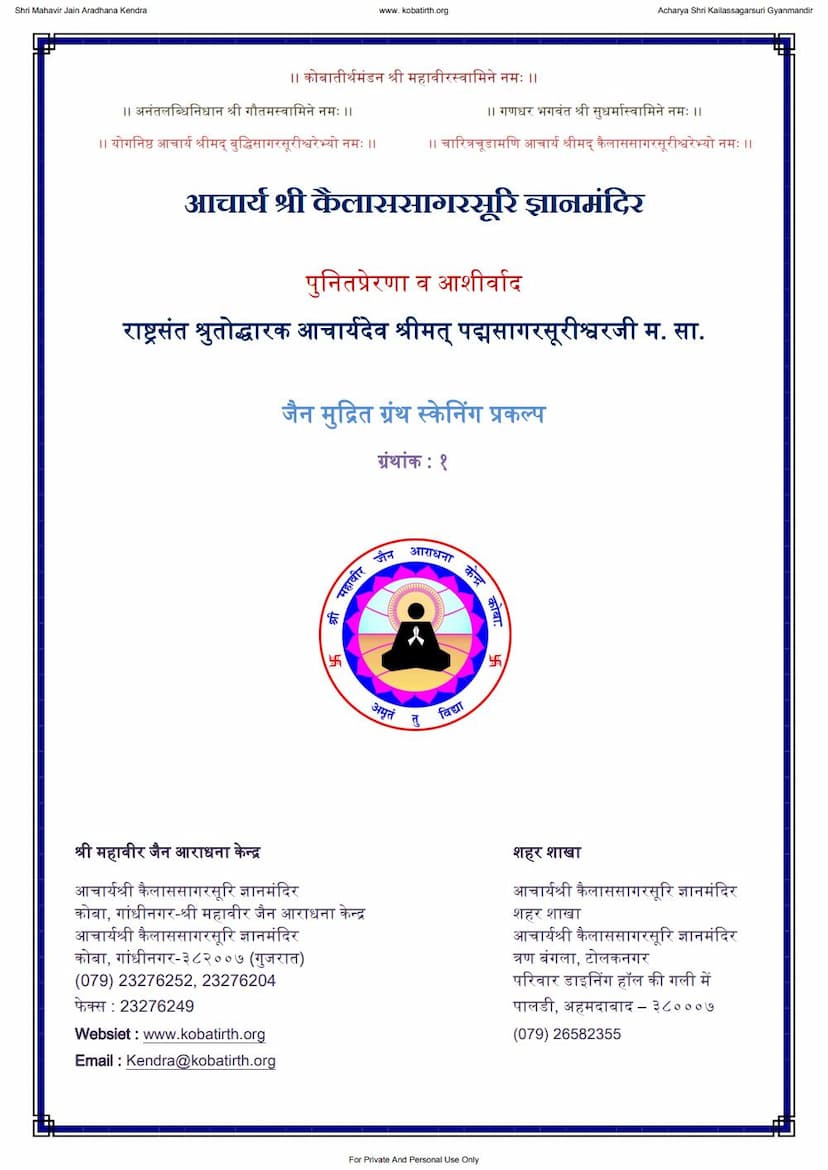Ras Gangadhar
Added to library: September 2, 2025

Summary
Here's a comprehensive summary of the Jain text "Ras Gangadhar" by Jagganath Pandit, based on the provided pages. Please note that the text is primarily a treatise on Sanskrit poetics (Alankara Shastra) and not a Jain text, despite its inclusion in the Jain Granth Scanning project. The summary will focus on the content of the book as a work of poetics:
Book Title: Ras Gangadhar (रसगङ्गाधरः) Author: Jagganath Pandit (जगन्नाथ पण्डित) Publisher: Nirnaysagar Yantralaya, Mumbai Catalog Link: https://jainqq.org/explore/020600/1
Overall Nature of the Text: "Ras Gangadhar" is a seminal work on Sanskrit poetics, authored by the renowned poet and scholar Jagganath Pandit. It is a comprehensive treatise that delves deeply into the nuances of Rasa (aesthetic sentiment), Dhvani (suggestion), Alankara (figures of speech), Guna (qualities of poetry), Riti (style), and Dosha (defects in poetry). The book is highly analytical and offers detailed explanations and classifications of these poetic concepts, often engaging with and critiquing earlier theories by scholars like Anandavardhana, Mammata, Appayya Dikshita, and Vishvanatha. The text is written in Sanskrit and is accompanied by a commentary by Nagesh Bhatta.
Key Sections and Concepts Covered (Based on the provided Table of Contents and sample pages):
The provided pages outline a vast and detailed exploration of poetics, covering the following major areas:
-
First Chapter (प्रथममाननम् - Prathama Mananam):
- Mangalacharan (मङ्गलाचरणम्): Invocation to deities.
- Kavya Lakshanam and Bhedas (काव्यलक्षणम्, काव्यभेदाः): Definition and classification of poetry (e.g., Uttamotttama, Uttama, Madhyama, Adhama Kavya).
- Rasa Lakshanam and Bhedas (रसलक्षणम्, रसभेदाः): Definition and classification of aesthetic sentiments (Rasa). This includes detailed discussions on:
- Sthayi Bhavas (स्थायिभावाः): The dominant emotions (e.g., Rati, Shoka, Nirveda, Krodha, Utsaha, Vismaya, Jugupsa).
- Vibhava (विभाव): Determinants of emotion (Alambana and Uddipana Vibhava).
- Anubhava (अनुभाव): Consequents of emotion.
- Vyabhichari Bhava (व्यभिचारिभाव): Transitory emotions.
- Specific Rasas (रस): Detailed analysis of Shringara (conjugal love), Karuna (pathos), Shanta (peaceful), Raudra (anger), Veera (heroism), Adbhuta (wonder), Hasya (humor), Bhayanaka (fear), Bibhatsa (disgust).
- Rasa-bhasa (रसभास): Perversions or imitations of Rasa.
- Bhavashanti, Bhavodaya, Bhavasandhi, Bhavashabala (भावशान्ति, भावोदय, भावसंधि, भावशबलत्व): States of emotions.
- Shabdaguna and Arthaguna (शब्दगुणभेदाः, अर्थगुणाः): Qualities of sound (e.g., Prasada, Samata, Madhurya, Ojaha, Kantih, Sukumarata) and meaning (e.g., Shlesh, Prasada, Samata, Madhurya, Sukumarata, Arthavyakti, Udara).
- Dhvani (ध्वनि): The concept of suggestion or implied meaning, including its types (Sabda-shakti-mula, Artha-shakti-mula, Lakshana-mula, Abhidha-mula).
- Alankara Prakarana (अलंकारप्रकरणम्): Figures of speech, covering a vast array of devices like Upama (simile), Rupaka (metaphor), Arthantaranyasa (comparison), Nidarsana, Vyathireka, Atishayokti (hyperbole), Utpreksha (poetic exaggeration), Deepaka, Tulyayogita, etc., and their sub-categories and potential defects.
- Varna and Riti (वर्णविचार, रीति): Phonetics and stylistic conventions (e.g., Vaidarbhi Riti).
-
Second Chapter (द्वितीयमाननम् - Dwitiya Mananam):
- Further discussions on Dhvani (especially Vyanjana - व्यञ्जना).
- Detailed analysis of Vyabhichari Bhavas (व्यभिचारिभाव) and their classifications.
- Rasa-bhasa (रसभास) and its types.
- Bhavashanti, Bhavodaya, Bhavasandhi, Bhavashabala (भावशान्ति, भावोदय, भावसंधि, भावशबलत्व).
- More figures of speech (Alankaras).
Author's Perspective and Style: Jagganath Pandit, also known as Panditaraja, was a towering figure in Sanskrit literature. His approach in "Ras Gangadhar" is highly scholarly, systematic, and critical. He meticulously defines terms, classifies phenomena, and provides numerous examples, often quoting from classical Sanskrit literature. He also engages in debates with earlier traditions, presenting his own reasoned conclusions. His command of language and profound understanding of poetics are evident throughout the text.
Significance: "Ras Gangadhar" is considered one of the most important and authoritative texts on Sanskrit poetics. It synthesizes and expands upon previous theories, offering a refined and comprehensive framework for understanding poetic beauty and expression. It remains a crucial resource for scholars and students of Sanskrit literature and poetics.
Note on Jain Context: While the provided catalog link suggests a Jain context for the scanning or preservation project, the content of "Ras Gangadhar" itself is deeply rooted in Brahmanical Sanskrit literary tradition, specifically dealing with concepts central to Hindu aesthetics and poetics like Rasa, Dhvani, and Alankara. There is no indication within the excerpt that the text itself is a Jain scripture or philosophy. The preservation might be part of a larger effort to digitize and make accessible diverse Indian manuscripts, regardless of their originating religious tradition.
This summary focuses on the grammatical and literary content of "Ras Gangadhar" as presented in the provided pages.